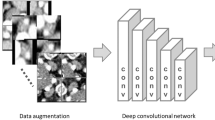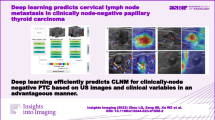Abstract
Purpose
This study aimed to validate a deep learning model’s diagnostic performance in using computed tomography (CT) to diagnose cervical lymph node metastasis (LNM) from thyroid cancer in a large clinical cohort and to evaluate the model’s clinical utility for resident training.
Methods
The performance of eight deep learning models was validated using 3838 axial CT images from 698 consecutive patients with thyroid cancer who underwent preoperative CT imaging between January and August 2018 (3606 and 232 images from benign and malignant lymph nodes, respectively). Six trainees viewed the same patient images (n = 242), and their diagnostic performance and confidence level (5-point scale) were assessed before and after computer-aided diagnosis (CAD) was included.
Results
The overall area under the receiver operating characteristics (AUROC) of the eight deep learning algorithms was 0.846 (range 0.784–0.884). The best performing model was Xception, with an AUROC of 0.884. The diagnostic accuracy, sensitivity, specificity, positive predictive value, and negative predictive value of Xception were 82.8%, 80.2%, 83.0%, 83.0%, and 80.2%, respectively. After introducing the CAD system, underperforming trainees received more help from artificial intelligence than the higher performing trainees (p = 0.046), and overall confidence levels significantly increased from 3.90 to 4.30 (p < 0.001).
Conclusion
The deep learning–based CAD system used in this study for CT diagnosis of cervical LNM from thyroid cancer was clinically validated with an AUROC of 0.884. This approach may serve as a training tool to help resident physicians to gain confidence in diagnosis.
Key Points
• A deep learning-based CAD system for CT diagnosis of cervical LNM from thyroid cancer was validated using data from a clinical cohort. The AUROC for the eight tested algorithms ranged from 0.784 to 0.884.
• Of the eight models, the Xception algorithm was the best performing model for the external validation dataset with 0.884 AUROC. The accuracy, sensitivity, specificity, positive predictive value, and negative predictive value were 82.8%, 80.2%, 83.0%, 83.0%, and 80.2%, respectively.
• The CAD system exhibited potential to improve diagnostic specificity and accuracy in underperforming trainees (3 of 6 trainees, 50.0%). This approach may have clinical utility as a training tool to help trainees to gain confidence in diagnoses.




Similar content being viewed by others
Abbreviations
- AI:
-
Artificial intelligence
- AUROC:
-
Area under the receiver operating characteristic curve
- CAD:
-
Computer-aided diagnosis
- CNN:
-
Convolutional neural network
- CT:
-
Computed tomography
- FNA:
-
Fine-needle aspiration
- LNM:
-
Lymph node metastasis
- NPV:
-
Negative predictive value
- PPV:
-
Positive predictive value
- PTC:
-
Papillary thyroid carcinoma
- US:
-
Ultrasonography
References
Savadjiev P, Chong J, Dohan A et al (2019) Demystification of AI-driven medical image interpretation: past, present and future. Eur Radiol 29(3):1616–1624
McBee MP, Awan OA, Colucci AT et al (2018) Deep learning in radiology. Acad Radiol 25:1472–1480
Soffer S, Ben-Cohen A, Shimon O, Amitai MM, Greenspan H, Klang E (2019) Convolutional neural networks for radiologic images: a radiologist’s guide. Radiology 290:590–606
Park SH, Han K (2018) Methodologic guide for evaluating clinical performance and effect of artificial intelligence technology for medical diagnosis and prediction. Radiology 286:800–809
Yoo YJ, Ha EJ, Cho YJ, Kim HL, Han M, Kang SY (2018) A computer-aided diagnosis system for thyroid nodules on ultrasonography: initial clinical experience. Korean J Radiol 19(4):665–672
Jeong EY, Kim HL, Ha EJ, Park SY, Cho YJ, Han M (2018) Computer-aided diagnosis system for thyroid nodules on ultrasonography: diagnostic performance and reproducibility based on the experience level of operators. Eur Radiol 29(4):1978–1985
Kim HL, Ha EJ, Han M (2019) Real-world performance of computer-aided diagnosis system for thyroid nodules using ultrasonography. Ultrasound Med Biol 45(10):2672–2678
Ha EJ, Baek JH, Na DG (2019) Deep convolutional neural network models for the diagnosis of thyroid cancer. Lancet Oncol 2019;20(3):e130
Shin JH, Baek JH, Chung J et al (2016) Ultrasonography diagnosis and imaging-based management of thyroid nodules: revised Korean Society of Thyroid Radiology Consensus Statement and Recommendations. Korean J Radiol 17:370–395
Haugen BR (2017) 2015 American Thyroid Association Management guidelines for adult patients with thyroid nodules and differentiated thyroid cancer: what is new and what has changed? Cancer 123:372–381
Suh CH, Baek JH, Choi YJ, Lee JH (2017) Performance of CT in the preoperative diagnosis of cervical lymph node metastasis in patients with papillary thyroid cancer: a systematic review and meta-analysis. AJNR Am J Neuroradiol 38:154–161
Lee Y, Kim JH, Baek JH et al (2018) Value of CT added to ultrasonography for the diagnosis of lymph node metastasis in patients with thyroid cancer. Head Neck 40:2137–2148
Lee JH, Ha EJ, Kim JH (2019) Application of deep learning to the diagnosis of cervical lymph node metastasis from thyroid cancer with CT. Eur Radiol 29:5452–5457
Simonyan K, Zisserman A (2014) Very deep convolutional networks for large-scale image. arXiv1409.1556
He K, Zhang X, Ren S, Sun J (2016) Deep residual learning for image recognition. In: Proceedings of the IEEE conference on computer vision and pattern recognition. pp 770–778
Chollet F (2017) Xception: deep learning with depthwise separable convolutions. In: Proceedings of the IEEE conference on computer vision and pattern recognition. pp 1251–1258
Szegedy C, Vanhoucke V, Ioffe S, Shlens J, Wojna Z (2016) Rethinking the inception architecture for computer vision. In: Proceedings of the IEEE conference on computer vision and pattern recognition. pp 2818–2826
Szegedy C, Ioffe S, Vanhoucke V, Alemi AA (2017) Inception-v4, inception-ResNet and the impact of residual connections on learning. In: Thirty-First AAAI Conference on Artificial Intelligence
Iandola F, Moskewicz M, Karayev S, Girshick R, Darrell T, Keutzer K (2014) Densenet: Implementing efficient convnet descriptor pyramids. ArXiv Preprint arXiv1404.1869
Russakovsky O, Deng J, Su H et al (2015) Imagenet large scale visual recognition challenge. Int J Comput Vis 115:211–252
Grinberg M (2018) Flask web development: developing web applications with python. O’Reilly Media
Zhou B, Khosla A, Lapedriza A, Oliva A, Torralba A (2016) Learning deep features for discriminative localization. In: Proceedings of the IEEE conference on computer vision and pattern recognition. pp 2921–2929
Selvaraju RR, Cogswell M, Das A, Vedantam R (2017) Grad-cam: visual explanations from deep networks via gradient-based localization. In: Proceedings of the IEEE International Conference on Computer Vision. pp 618–626
Giger ML (2018) Machine learning in medical imaging. J Am Coll Radiol 15:512–520
Choi YJ, Baek JH, Park HS et al (2017) A computer-aided diagnosis system using artificial intelligence for the diagnosis and characterization of thyroid nodules on ultrasound: initial clinical assessment. Thyroid 27:546–552
Funding
This study has received funding by the National Research Foundation of Korea (no. 2017R1C1B5016217).
Author information
Authors and Affiliations
Corresponding author
Ethics declarations
Guarantor
The scientific guarantor of this publication is Eun Ju Ha.
Conflict of interest
The authors of this manuscript declare no relationships with any companies whose products or services may be related to the subject matter of the article.
Statistics and biometry
One of the authors has significant statistical expertise.
Informed consent
Written informed consent was waived by the Institutional Review Board.
Ethical approval
Institutional Review Board approval was obtained.
Methodology
Retrospective
Diagnostic or prognostic study
Performed at one institution
Additional information
Publisher’s note
Springer Nature remains neutral with regard to jurisdictional claims in published maps and institutional affiliations.
Rights and permissions
About this article
Cite this article
Lee, J.H., Ha, E.J., Kim, D. et al. Application of deep learning to the diagnosis of cervical lymph node metastasis from thyroid cancer with CT: external validation and clinical utility for resident training. Eur Radiol 30, 3066–3072 (2020). https://doi.org/10.1007/s00330-019-06652-4
Received:
Revised:
Accepted:
Published:
Issue Date:
DOI: https://doi.org/10.1007/s00330-019-06652-4




